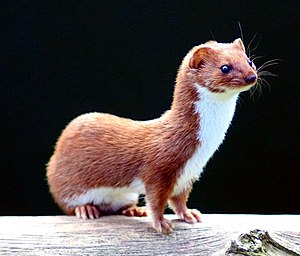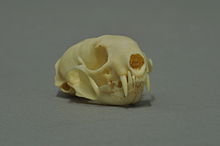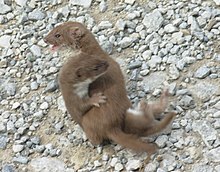Mouse weasel
| Mouse weasel | ||||||||||||
|---|---|---|---|---|---|---|---|---|---|---|---|---|

Mouse weasel |
||||||||||||
| Systematics | ||||||||||||
|
||||||||||||
| Scientific name | ||||||||||||
| Mustela nivalis | ||||||||||||
| Linnaeus , 1766 |
The mouse weasel ( Mustela nivalis ), also called dwarf or small weasel or popularly called Hermännchen , is a species of predator from the marten family (Mustelidae). In addition to the ermine , it is the second species of weasel native to Central Europe .
features

The mouse weasel is the smallest representative of the order of carnivores (Carnivora), even if there are considerable differences in size in its large area of distribution. The length of the head body varies between 11 and 26 centimeters, the tail length between 2 and 8 centimeters and the weight between 25 and 250 grams. The animals in North America generally stay smaller than the animals in Eurasia and are called the Least Weasel there . Likewise, females are on average smaller and lighter than males. The fur of the little weasel differs from the ermine in the jagged line between the brown top and the white underside, as well as brown feet and a brown tail (without the black tip).
As with ermine, weasels can also change their coat with white winter fur, but this occurs only very rarely in Central Europe. There are regional populations, for example in the Nock Mountains in Austria or Lithuania, which also turn white in winter.
distribution and habitat
Mouse weasels are native to almost the entire Palearctic region and North America. Their distribution area extends from Western Europe to Japan and China and, in contrast to the ermine, also includes the Mediterranean region and northern Africa . Only in Ireland , Iceland and the Arctic Islands do they not live. In North America, they are common in Alaska , nearly all of Canada, and the northern United States . After New Zealand the species was introduced.
Mouse weasels inhabit a number of habitats , including grassland and fallow vineyards, forest edges, meadows and pastures. In summer, in particular, they reach high population densities in agricultural areas. Linear structures such as hedges, unkempt ditches, old grass strips and field edges are used for locomotion and hunting. Deep forests, deserts and mountains over 3000 meters high are avoided.
Way of life
Mouse weasels can be on the move both during the day and at night, but in most cases they are active during the day or at dusk. They use dense vegetation, crevices, hollow tree trunks, stone piles or burrows of other animals as cover and shelter. The nests, mostly formerly used by mice, are lined with dry vegetation, hair or feathers.
Mouse weasels presumably live solitary outside of the mating season. With good feeding conditions, they are faithful to their location, with the males using up to 50 hectares of territories and females using smaller areas. The boundaries of their territory are marked with the secretion of their anal glands . In the main mating season from March to October, males are usually nomadic in search of reproductive females. Encounters with other males are avoided, but can also result in aggressive confrontations.
food
The diet of the mouse weasel consists primarily of small mammals, especially rodents , preferably voles . Their physique makes them ideal for underground hunting in mouse tunnels . Because of their very narrow food spectrum, weasels are bound to habitats with a minimum density of mice, whereby they can also switch to other food such as birds and their eggs, young rabbits or lizards for a short time and depending on the season. Due to their high basal metabolism, however, these small predators are dependent on a continuous supply of their energy needs.
Weasels are known to attack and kill prey that are much larger than themselves, such as rabbits and even adult rats. They also often kill more animals than they can eat. Usually the victim is killed by biting the neck.
Reproduction and Life Expectancy
Mating can occur all year round, even in the arctic regions in winter, as long as there is enough food. The high point of the breeding season is, however, in spring and late summer, under favorable conditions a female can have offspring twice a year. The gestation period lasts around 34 to 37 days, the litter size averages five and can vary from three to ten. Newborns are very small (1.5 grams) and blind, after a month they open their eyes, after one and a half to two months they are weaned. The rearing of the young is the sole responsibility of the females, who become sexually mature at three months and can reproduce in their first year of life.
Many animals die in their first year of life, in the wild they can reach an age of three to five years at most. Their natural enemies include birds of prey , owls , foxes and ermines . In captivity, weasels can live up to nine years.
Mouse weasel and human
Since mouse weasels primarily feed on rodents that are viewed as pests , humans treat them with goodwill. They were also kept for this purpose and introduced into some islands and regions that were not part of their original habitat. In contrast to related species, the hunt for the mouse weasel only plays a very subordinate role. Regionally, populations can be threatened by the destruction of their habitat, but globally, mouse weasels are not endangered species. Even if you only rarely see them in nature, an occurrence of mouse weasels is to be expected in almost every habitat in their area of distribution.
In superstition, the mouse weasel is considered a harbinger of bad luck that has an evil influence on people. The hiss emitted by the mouse weasel as a warning was interpreted as a sign of " demonic poisoning". Especially at the time of the witch hunt , the mouse weasel in its role as a demonic house ghost was considered a sign of witchcraft .
In 2013 it was declared animal of the year in Germany . Except for Bavaria , Bremen and Schleswig-Holstein , the mouse weasel is protected in Germany and is spared all year round . In North Rhine-Westphalia it was completely removed from the list of huntable species with the 2015 Ecological Hunting Act. In Austria, where, like in Germany, hunting is a matter of the state, the status is also different. While the mouse weasel is hunted all year round in Burgenland , Lower Austria and Vienna , it has a four-month closed season in Styria and is spared all year round in the other five federal states. In Switzerland, the mouse weasel is listed on the Red List of Endangered Species and is protected nationwide. The population decline is countered here with various weasel funding projects .
The reason given for hunting is often the allegation that weasels are to be blamed for cable damage in cars. In fact, these are almost always stone marten and not mouse weasel.
literature
- Ronald M. Nowak: Walker's Mammals of the World . 6th edition. Johns Hopkins University Press, Baltimore 1999, ISBN 0-8018-5789-9 (English).
- Bettina Schmitt: The mouse weasel in the cultural landscape. Abundance, territorial systems and habitat use. Laurenti, Bielefeld 2006, ISBN 978-3-933066-30-5 .
Web links
- Mustela nivalis in the endangered Red List species the IUCN 2008. Posted by: A. Tikhonov u. a., 2008. Retrieved January 1, 2009.
- Wildlife Biology Working Group - with picture
- BUND Lemgo, mouse weasel and ermine
Individual evidence
- ↑ Welt am Sonntag : The world's smallest robber , February 2004, accessed July 31, 2017
- ↑ Hamburger Abendblatt : Mauswiesel: cute, but dangerous , accessed July 31, 2017
- ↑ Angela Kämper: Animal messengers: What encounters with animals tell us - mythology, spirituality, dreams . Goldmann Verlag, 2009.
- ^ The ecological hunting law NRW , accessed on July 31, 2017.
- ↑ Wiesellandschaft Schweiz , accessed on July 31, 2017.
- ↑ shz.de : Hunters warn of more martens in SH , accessed July 31, 2017
- ↑ Note: Ermine and weasel should not be confused with the martens who like to eat a cable ( memento from August 1, 2017 in the Internet Archive ), accessed July 31, 2017




